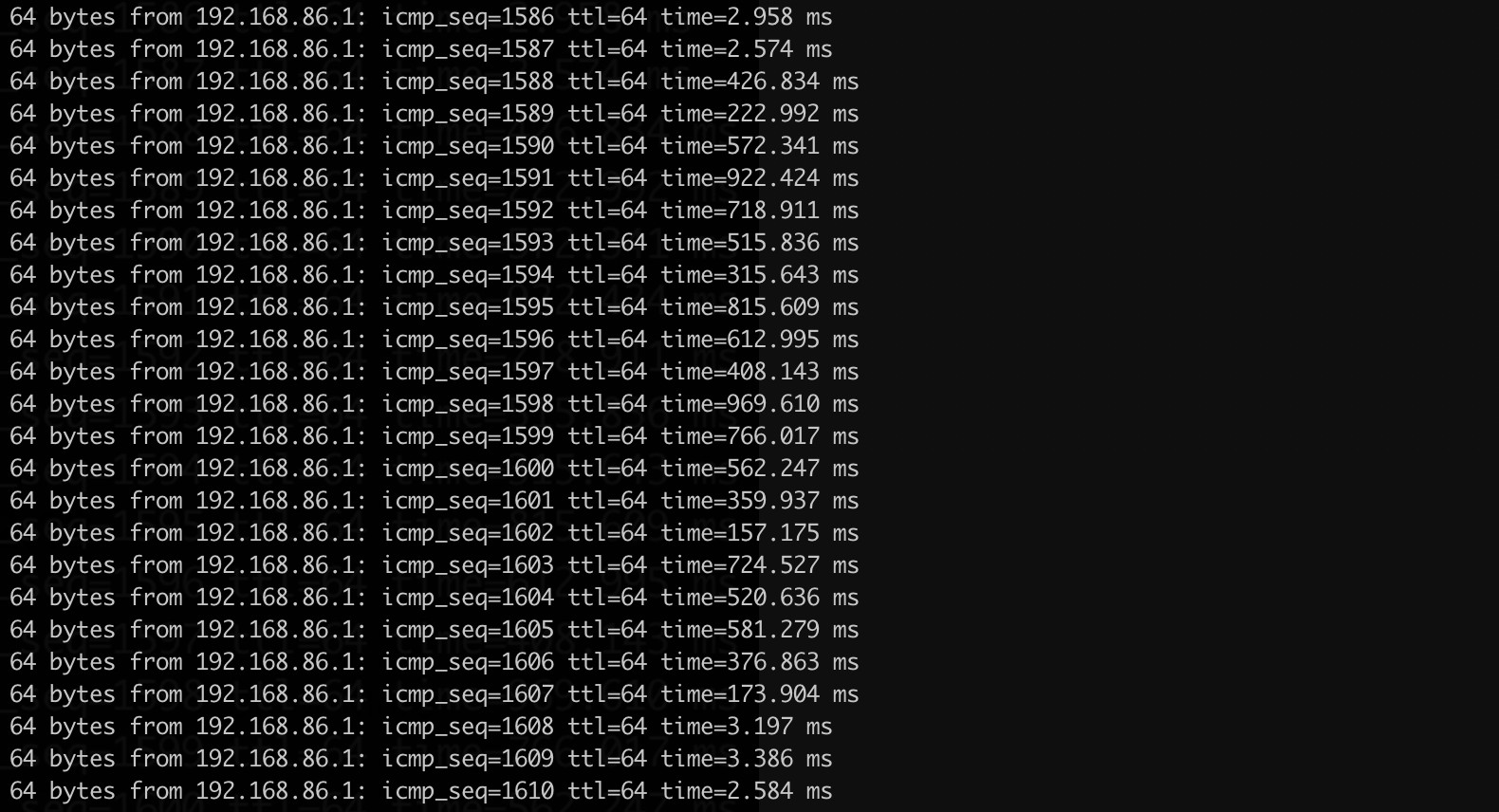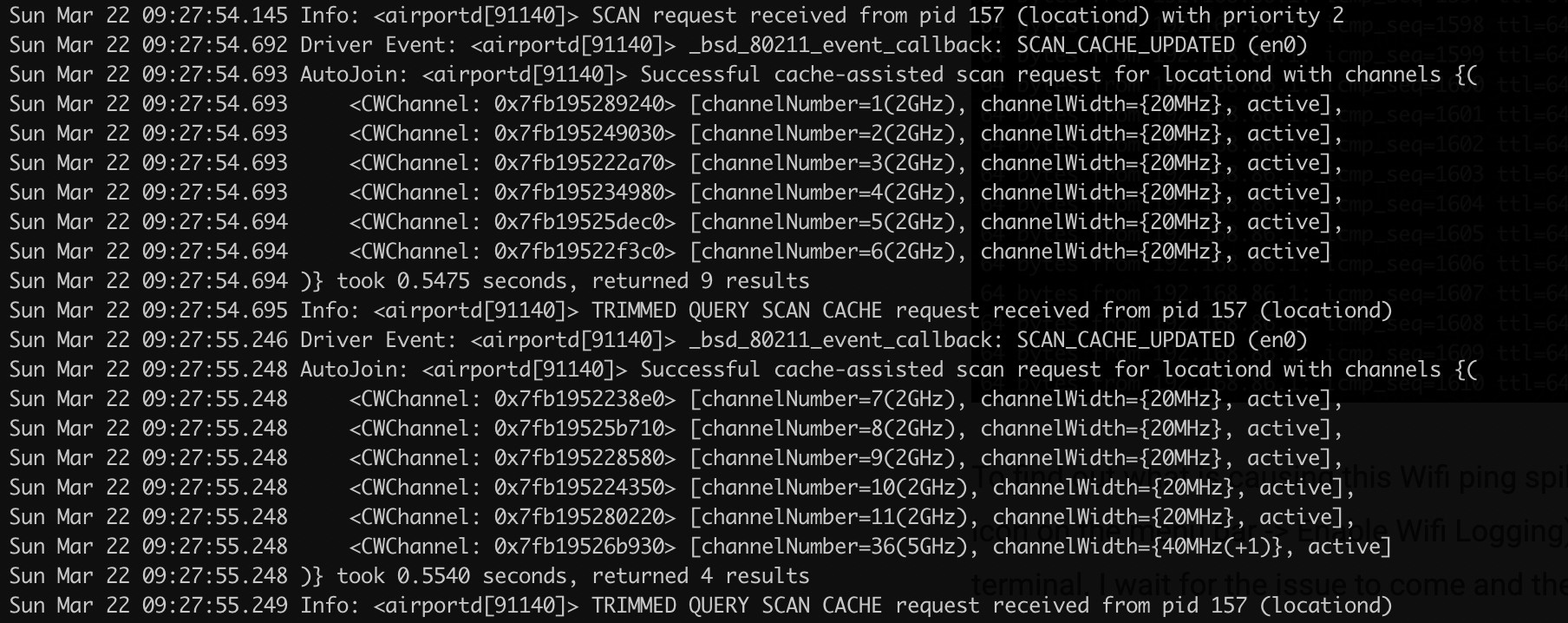Table of Contents
Table of Contents
Remote work and work-from-home comes with its own set of challenges, and unexpected Wi-Fi hiccups can be a major roadblock. One often-overlooked culprit behind those latency spikes on your MacOS device? The unassuming Location Service.
In this blog post, we'll shed light on how Location Service interactions might be causing disruptions in your Wi-Fi connectivity. More importantly, we'll equip you with practical solutions to restore the smooth flow of your remote work. Let's dive in and unravel the mystery behind those bothersome Wi-Fi slowdowns and latency spikes on your Mac.
WiFi latency spikes refer to sudden and temporary delays or lags in the transmission of data over a wireless network. In simpler terms, when you experience latency spikes, there's a delay between sending and receiving data, causing a brief interruption in the smooth flow of online activities.
These spikes can manifest in various ways, such as:
- Slow Responsiveness: Devices may take longer to respond to your commands or actions.
- Choppy Video Calls: During video calls, you might notice freezes, pixelation, or audio glitches.
- Buffering Issues: Streaming services may struggle to maintain a consistent flow, leading to buffering interruptions.
- Online Gaming Disruptions: Gamers may experience delays in actions and responses, affecting the overall gaming experience.
WiFi latency spikes can result from a variety of factors, including network congestion, interference, or, as explored in this blog, interactions with the MacOS Location Service. Identifying and addressing the root cause is crucial to maintaining a stable and reliable wireless connection for optimal online performance.
We asked a supercomputer “What is latency”, its impact on network performance, and strategies for minimizing it and created this comprehensive guide.
Learn more

To avoid WiFi latency spikes/ping spikes every 5 minutes:
- Disable macOS Location Service:
(Settings -> Security & Privacy -> Privacy -> Location Services) - And don't allow "Find my location" in any apps (e.g. Google Chrome)
The majority of workers these days work from home or remote locations a lot of the time. Working from home means a lot of video-conferencing with Zoom, GotoMeetings, WebEx and Teams. The convenience of working from home, however, comes with its own set of challenges, particularly in terms of connectivity.
As I engaged in virtual meetings, I began noticing disruptions in the form of frozen images and muted conversations—issues rarely encountered in the structured environment of the office. This led me to think about three potential culprits:
Home Internet Connection: Perhaps the home Internet connection is not as robust as the one at the office, resulting in intermittent disruptions during video calls.
ISP Network Congestion: The Internet Service Provider (ISP) might be facing capacity issues, leading to network congestion during peak usage times.
WiFi vs. Ethernet: At the office, we rely on a stable Ethernet connection, but at home, we connect via WiFi. So we questioned whether this change in connectivity method could be contributing to the observed issues during virtual meetings.
Recognizing these potential factors prompted a deeper investigation into the root cause of the connectivity challenges, ultimately guiding me towards a solution to ensure smoother remote work experiences.
To pinpoint and address MacOS WiFi latency spikes effectively, we recommend implementing a comprehensive Network Performance Monitoring Tool like Obkio. Deploying an end-to-end solution like Obkio allows for real-time monitoring and analysis of the entire network infrastructure, so you can poractively identify potential bottlenecks, packet loss, and latency issues with precision.
This proactive approach not only facilitates the swift detection of connectivity issues but also provides valuable insights into the specific elements contributing to WiFi latency spikes. By leveraging Obkio's capabilities, users can streamline the troubleshooting process, enhance network performance, and ensure a seamless online experience on MacOS devices.

You can deploy Obkio in just 10 minutes using the 14-day free trial and Onboarding Wizard so you can start troubleshooting WiFi latency spikes in minutes!
- 14-day free trial of all premium features
- Deploy in just 10 minutes
- Monitor performance in all key network locations
- Measure real-time network metrics
- Identify and troubleshoot live network problems

using continuous synthetic traffic from Network Monitoring Agents deployed in your most important network locations like offices, data centers and clouds. The Agents identify latency issues like latency spikes in your network by sending and monitoring data packets through your network every 500ms.
This is extremely important for identifying even the smallest amount of VoIP latency since VoIP is especially sensitive to network issues.
To deploy latency monitoring in all your network locations, we recommend deploying:
Local Agents: Installed in the targeted office location experiencing latency spikes. There are several Agent types available (all with the same features), and they can be installed on MacOS, Windows, Linux and more. Public Monitoring Agent: These are deployed over the Internet and managed by Obkio. They compare performance up to the Internet and quickly identify if the latency issue is global or specific to the destination. For example, measure VoIP latency between your head office and a user’s remote workstation in another location.

Once you’ve set up your Monitoring Agents, they will start measuring key network metrics like Internet latency and collecting data, which you can easily analyze on Obkio’s Network Response Time Graph. Obkio continuously collects and analyzes key network metrics such as latency, jitter, packet loss, and bandwidth utilization. This meticulous monitoring occurs at various points within the network infrastructure, providing a comprehensive view of the entire data transmission process.
By examining these metrics in real-time, Obkio can pinpoint the exact location and nature of potential issues contributing to WiFi latency spikes. This granular insight allows you to act fast to troublshoot the latency spikes and ensure a stable and responsive connectivity experience for MacOS users.

Obkio meticulously measures and analyzes several essential network metrics to identify and address WiFi latency spikes on MacOS devices. These key metrics include:
Latency: The time it takes for data to travel from the source to the destination, influencing the responsiveness of network connections.
Jitter: Variability in the delay of received data packets, affecting the consistency of data transmission and potentially leading to disruptions.
Packet Loss: The percentage of data packets that do not reach their intended destination, which can result in data retransmissions and impact overall network performance.
Bandwidth Utilization: The percentage of available network capacity being used at any given time, providing insights into potential congestion and resource limitations.
By continuously monitoring and assessing these metrics in real-time, Obkio enables users to detect, diagnose, and resolve WiFi latency spikes promptly, ensuring an optimized and reliable network performance for MacOS users.
With Obkio deployed, you know have all the information you need to not only identify the WiFi latency spikes, but also to understand the causes of them. Earlier, we discussed the three possible causes of the WiFi latency spikes, so now, we'll discuss how we identified them or eliminated them from the occassion.
One of the assumptions was that poor home Internet connection was the cause of the problem. This happens quite often as home Internet connections may not be as robust as the one at the office, resulting in intermittent disruptions during video calls.
The next assumption was that the Internet Service Provider (ISP) might be facing capacity issues, leading to network congestion during peak usage times.
The first two possible causes were quite easy to verify using Obkio's Hardware Agent X1001 connected to my home network with monitoring sessions with Public Monitoring Agents installed at AWS, Google Cloud and Microsoft Azure. This setup allowed us to monitor network and Internet performance between the home office and the Internet.
But doing this, we were quickly able to confirm that the Mac Wifi connection was pretty stable and that there was no jitter, high latency or packet loss during the video calls with image freezing issues.
At this point, we figured that the issue of Mac ping spikes on WiFi was probably related to the WiFi network, even though our setup is supposed to be pretty strong: Google Wifi with 3 Access Points all wired with Ethernet cables.
Aside from the causes we listed earlier, WiFi latency spikes on Mac can be caused by a variety of other factors that you may encounter instead. Some these other possible causes of Mac WiFi latency spikes include:
- Network Congestion: High levels of traffic on your WiFi network or interference from other devices can lead to congestion, resulting in latency spikes.
- Router Issues: Outdated router firmware, configuration problems, or hardware issues with your router can contribute to latency problems.
- Signal Interference: Electronic devices such as cordless phones, microwave ovens, or neighboring WiFi networks can cause interference and lead to latency spikes.
- Channel Interference: Multiple devices using the same WiFi channel can cause interference, resulting in slower speeds and increased latency.
- Distance from Router: The farther your Mac is from the WiFi router, the weaker the signal, which can lead to increased latency.
- Network Overload: If too many devices are connected to the WiFi network simultaneously, it may overload the network capacity and cause latency issues.
- Background Processes and Apps: Certain apps or background processes on your Mac may be consuming network resources, contributing to latency spikes.
- MacOS Location Service: As discussed earlier, interactions with the MacOS Location Service can unexpectedly impact WiFi performance.
- ISP Issues: ISP issues or problems with your Internet Service Provider, such as network outages, insufficient bandwidth, or issues with the ISP's infrastructure, can contribute to latency spikes.
- Software or Driver Issues: Outdated or incompatible WiFi drivers or software on your Mac can result in connectivity issues and latency spikes.
Identifying the specific cause requires a systematic approach, considering both hardware and software elements, and often involves using network monitoring tools to diagnose and address the underlying issues.

Anyways, let's dig into the network troubleshooting to finally get to the bottom of this issue.
On the MacBook Pro 2017 (running macOS Catalina 10.15.3), we installed the macOS software agent. The Software Agent is available for a various operating systems include macOS, Windows, Docker and Linux - so you can choose the one that's best for you.

After only a few minutes, early results were indicating that something was going on for sure! We quickly noticed big latency spikes exactly every 5 minutes.
So we compared the graphs of the two local agents (hardware agent (wired) and software agent (wifi)) with the AWS Monitoring Agent. We didn't see the same spikes in latency wired-vs-wifi as you can see in this screenshot:

It was very easy to see the issue with a single WiFi ping to the default gateway: ping -i 0.2 <IP>.

To find out what was causing these Wifi ping spikes, we enabled Wifi Logging (OPTION+Click on the Wifi icon on the menu bar -> Enable Wifi Logging).
Then executed tail -F /var/log/wifi.log in a terminal and waited for the Wifi spikes issue to shpw up. We then saw that it was the locationd process that issued a scan request.
You can use this same process to find out what causes latency spikes on wifi or wifi lag spikes.

Now that we knew exactly what was causing the latency spikes, we could finally get to fixing it! When your WiFi connection starts playing hide-and-seek every 5 minutes, it's time to roll up your sleeves and get to the bottom of the issue.
In this section, we've got three actionable solutions to tackle those pesky WiFi latency spikes on your MacOS. From putting the brakes on your Mac's location services to keeping a closer eye on Google Chrome's location permissions, we've got you covered. But there's a catch – even the seemingly harmless act of checking your WiFi stats can make matters worse. So, before you inadvertently stir the latency pot, let's dive into these solutions and ensure your online experience stays smooth and interruption-free.
The first solution to avoid these latency spikes on wifi every 5 minutes is to disable the MacOS Location Service: (Settings -> Security & Privacy -> Privacy -> Location Services)
By toggling off Location Services, you prevent your Mac from continuously scanning for its geographical location, which can contribute to periodic disruptions in WiFi connectivity. Disabling this feature eliminates one potential source of interference, offering a straightforward resolution to the latency issue.
Once in a while, we authorize some websites inside Google Chrome to know our location (e.g. Google Maps). When you visit these websites, it can trigger a location scan causing similar WiFi latency spikes.
Finding out if an application is requesting a wifi scan is very easy; simply look at the Wifi logs (/var/log/wifi.log) mentioned above.
To address this, regularly check the WiFi logs (/var/log/wifi.log) mentioned above to identify if any application, particularly Google Chrome, is initiating WiFi scans. By disabling location services within Google Chrome or adjusting its permissions for specific websites, you can curtail unnecessary scans and minimize the likelihood of WiFi disruptions during critical activities like video calls.
Although it's tempting to investigate WiFi stats by pressing the OPTION key while clicking on the WiFi icon in the menu bar, doing so can exacerbate latency issues.
By clicking on the Wifi icon on the menu bar with the OPTION key pressed, an advanced menu will display stats about current Wifi connection such as signal strength (RSSI), noise level, current BSSID, and wifi channel. When we have wifi issues, we like to take a look at these stats to know, for instance, if we're connected using a 2.4GHz or a 5GHz frequency.
This action triggers a comprehensive WiFi scan, going beyond the depth of a location service scan. While examining these stats provides valuable information about signal strength, noise level, BSSID, and WiFi channel, it simultaneously induces packet loss and higher latency spikes. To maintain a stable connection, especially during video calls, it's advisable to refrain from accessing these detailed WiFi stats, as doing so inadvertently worsens the WiFi situation. Prioritizing uninterrupted connectivity over real-time statistics is crucial for a smoother online experience.
Looks like we're not the only ones with this issue: https://forums.developer.apple.com/thread/97805. Apple is aware of the issue since at least 2018.
If you want to discuss this issue, join the discussion on our Forums at https://forums.obkio.com.
Navigating the intricate world of WiFi connectivity on MacOS comes with its share of challenges, but armed with the right solutions, you can bid farewell to those irritating latency spikes. By disabling MacOS and Google Chrome location services and resisting the temptation to dive too deep into WiFi stats, you're well on your way to a more reliable and stable connection.
However, for a more comprehensive and proactive approach to network performance monitoring, we recommend Obkio's end-to-end Network Monitoring tool. With its robust capabilities to measure crucial metrics and provide real-time insights, Obkio empowers you to identify and address potential latency issues with precision. Take control of your network, optimize your WiFi experience, and ensure uninterrupted productivity by incorporating Obkio into your arsenal of connectivity solutions.

Your MacOS deserves nothing less than the best – bid farewell to WiFi hiccups and embrace seamless online interactions with Obkio. Ready to supercharge your network?
- 14-day free trial of all premium features
- Deploy in just 10 minutes
- Monitor performance in all key network locations
- Measure real-time network metrics
- Identify and troubleshoot live network problems



























 Obkio Blog
Obkio Blog





